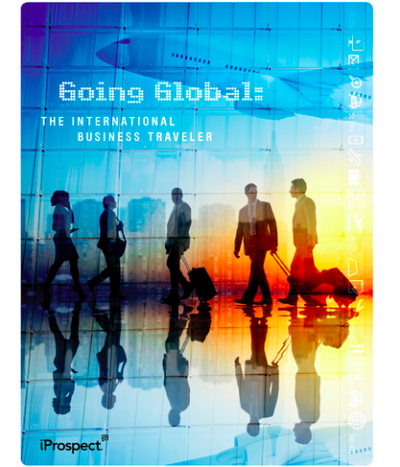 Affluent travelers, image courtesy of Victor private jets
Affluent travelers, image courtesy of Victor private jets
International business travelers should be a high-priority target for brands because of the group’s spending power and youth, according to a new report from iProspect. International business travelers (IBTs) comprise 5.2 million people in the United States and account for up to $20 billion in annual spend, numbers that make them at least as valuable as affluents and millennials for marketing campaigns. These consumers are largely unfazed by traditional advertising, however, meaning that brands will need to perfect digital and mobile advertising to more effectively tap into the pool of wealth. "Mobile support is a basic requirement for the IBT, just like many other consumer groups," said Andrea Wilson, vice president, strategy director and luxury practice lead at iProspect. "If a brand doesn’t support the technology, the IBT will become frustrated and stop going to the brand’s mobile experience. This will lead them to a competitor site instead.
"Brands need to prioritize their mobile experience, as the majority of consumers use it as one of their primary computers. It’s also a direct extension of customer service as it is the most individual digital touchpoint. Ensuring the consumer can conveniently connect, gain answers and be inspired by the brand on their mobile phone is the ultimate way to service the customer."
For “Going Global: The International Business Traveler,” iProspect gathered data from 1,131 consumers who constitute IBTs and other international travelers, profiling them demographically and behaviorally to determine an effective way to reach them through advertising. Summarily, the findings revealed that international business travelers are prime targets for luxury brands to market to, but they must take advantage of digital and mobile channels to effectively do so. On the road again Eighty-one percent of IBTs travel abroad at least one a month and nearly a third do so weekly. Demographically, almost three-fourths of them are male, over two-thirds are married and/or have kids and 61 percent fall between the ages of 25 and 44, with an additional 30 percent spanning up to 64. They are mostly white, with a quarter being Hispanic and one-tenth Asian. Going Global report
Psychographically, a significant majority will pay more both for high quality and to save time, seek out digital ads related to their interests and indulge in luxury purchases for themselves. Due to the nature of their business travel, they rely extensively on mobile devices and tablets while abroad but also at home.
"Ninety-four percent of IBTs buy products and services online at least monthly, with half doing so at least weekly," Ms. Wilson said. "[The data shows] every industry is relevant to the IBT as they have disposable income, and a need and desire to buy."
Additionally, three-fifths add vacation time to every business trip and over half of IBTs (including two-thirds of U.S.-based IBTs) bring family along when they do.
The research finds that before trips brands must make themselves visible to travelers by ensuring they are near the top of search results, purchasing banner ad space on Web sites popular among IBTs and using sponsored content when possible. Among the best ways to ensure visibility is with social media campaigns, videos and ads and, crucially, ensuring that efforts are compatible across all devices.
During the trip, brands must maintain visibility, largely by matching the IBT's language preference and reaching out through local networks and incorporate links and thorough product information in ads, as well as making locations known.
Going Global report
Psychographically, a significant majority will pay more both for high quality and to save time, seek out digital ads related to their interests and indulge in luxury purchases for themselves. Due to the nature of their business travel, they rely extensively on mobile devices and tablets while abroad but also at home.
"Ninety-four percent of IBTs buy products and services online at least monthly, with half doing so at least weekly," Ms. Wilson said. "[The data shows] every industry is relevant to the IBT as they have disposable income, and a need and desire to buy."
Additionally, three-fifths add vacation time to every business trip and over half of IBTs (including two-thirds of U.S.-based IBTs) bring family along when they do.
The research finds that before trips brands must make themselves visible to travelers by ensuring they are near the top of search results, purchasing banner ad space on Web sites popular among IBTs and using sponsored content when possible. Among the best ways to ensure visibility is with social media campaigns, videos and ads and, crucially, ensuring that efforts are compatible across all devices.
During the trip, brands must maintain visibility, largely by matching the IBT's language preference and reaching out through local networks and incorporate links and thorough product information in ads, as well as making locations known.
 Gucci mobile ad on The Cut
After the trip and purchase, it is up to brands to maintain connections by creating spaces for user-generated content, mobile applications and personalized emails.
Maximizing reach
In addition to profiling a more specific target, the report further proves the importance of a strong mobile presence.
Back in April, L2’s Insight Report: Mobile Social Platforms emphasized the importance of mobile optimization for brands advertising on social media platforms such as Facebook, Instagram and Twitter. As consumers continue to use mobile devices at increasing rates and popular social media platforms adjust to make mobile use easier, it is essential for brands to keep up with these trends.
Other recent reports have also emphasized the importance of personalization and adapting strategies to individual consumers.
According to a new study by Yes Lifecycle Marketing, many retailers are still unwilling or unequipped to tailor customer service to the individual.
The study looks at retailers in a variety of different sectors and finds that many have not sufficiently tracked clientele and are thus unable to provide sales associates with the personalized data that will help initiate and close a transaction. With consumers navigating freely between mobile, Web and in-store shopping, and brands therefore able to gather more information than ever before about frequent shoppers, properly cataloguing clientele has emerged as a way to provide the best possible customer service and showcase a great branded experience (see story).
Many brands may also have to improve ecommerce channels to more reliably reach the IBT when he or she is abroad.
Global heterogeneity presents many obstacles for brands looking to maximize their share through localization efforts, according to a new report from L2.
The share of ecommerce sales in the luxury industry has tripled since 2009 and is set to triple again by 2025, but obstacles such as currency, language, selection and payment method may make it difficult for brands to expand and capitalize on their reach. As social media, the Web and the development of BRIC and Asian nations, as well as Sub-Saharan Africa in the future, give brands more visibility, it is essential that they monetize global consumers (see story).
If brands step up efforts to attract international business travelers, a broader range of coveted consumers may follow.
Gucci mobile ad on The Cut
After the trip and purchase, it is up to brands to maintain connections by creating spaces for user-generated content, mobile applications and personalized emails.
Maximizing reach
In addition to profiling a more specific target, the report further proves the importance of a strong mobile presence.
Back in April, L2’s Insight Report: Mobile Social Platforms emphasized the importance of mobile optimization for brands advertising on social media platforms such as Facebook, Instagram and Twitter. As consumers continue to use mobile devices at increasing rates and popular social media platforms adjust to make mobile use easier, it is essential for brands to keep up with these trends.
Other recent reports have also emphasized the importance of personalization and adapting strategies to individual consumers.
According to a new study by Yes Lifecycle Marketing, many retailers are still unwilling or unequipped to tailor customer service to the individual.
The study looks at retailers in a variety of different sectors and finds that many have not sufficiently tracked clientele and are thus unable to provide sales associates with the personalized data that will help initiate and close a transaction. With consumers navigating freely between mobile, Web and in-store shopping, and brands therefore able to gather more information than ever before about frequent shoppers, properly cataloguing clientele has emerged as a way to provide the best possible customer service and showcase a great branded experience (see story).
Many brands may also have to improve ecommerce channels to more reliably reach the IBT when he or she is abroad.
Global heterogeneity presents many obstacles for brands looking to maximize their share through localization efforts, according to a new report from L2.
The share of ecommerce sales in the luxury industry has tripled since 2009 and is set to triple again by 2025, but obstacles such as currency, language, selection and payment method may make it difficult for brands to expand and capitalize on their reach. As social media, the Web and the development of BRIC and Asian nations, as well as Sub-Saharan Africa in the future, give brands more visibility, it is essential that they monetize global consumers (see story).
If brands step up efforts to attract international business travelers, a broader range of coveted consumers may follow.
"We compared the IBT to affluents, millennials and leisure travelers, and the key difference is the IBT is much more intense of a group in terms of digital usage and positive advertising response," Ms. Wilson said. "IBTs are a combined group of all three segments, as they are affluent, some are of millennial age, and they also travel leisurely. The prime difference is their intense digital appreciation and advertising receptivity, making them a prime target for marketers to gain higher engagement levels than a more massive target.
"IBTs are the leaders of digital behaviors, and can teach marketers what tactics will work for the digital masses, as IBTs are early adopters," she said. "They expect quick answers, valuable benefits and personal connections from brands, more so than other groups. By catering to the IBT’s needs, brands can impress IBTs as well as general audiences."
Final Take Forrest Cardamenis, editorial assistant on Luxury Daily, New York